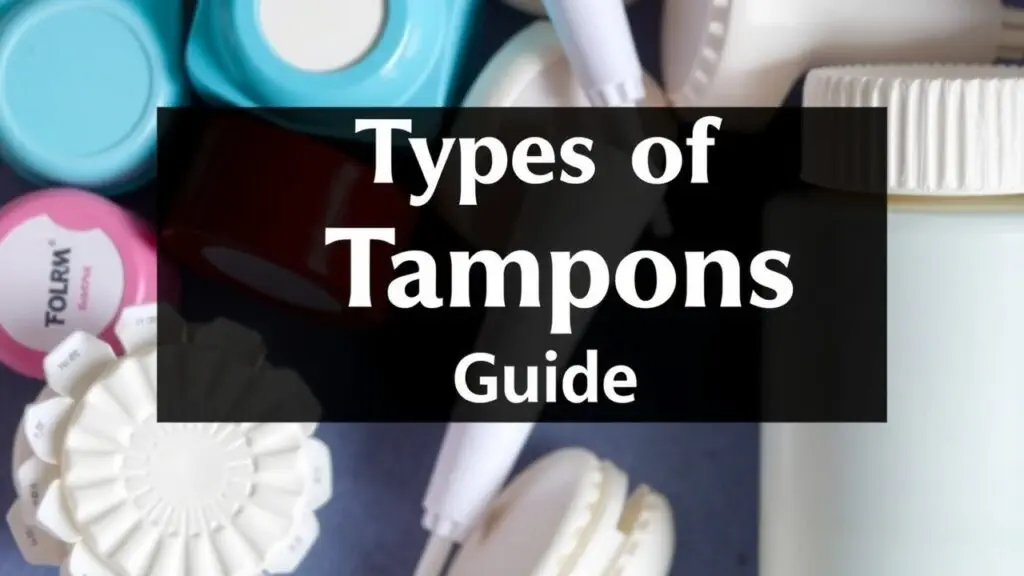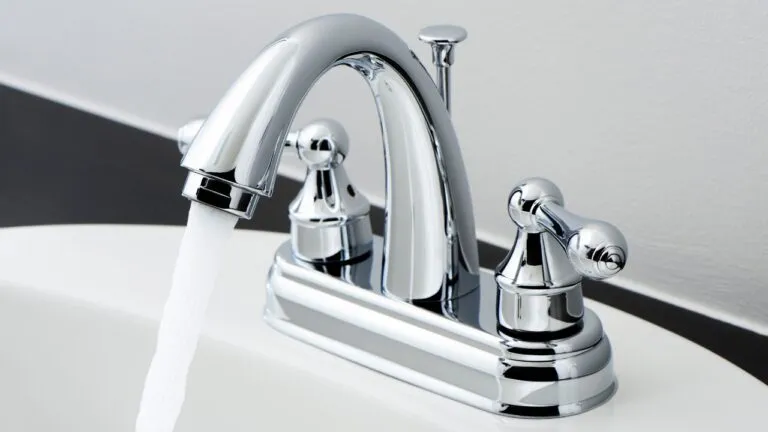Explore the different types of tampons. Choosing the right tampon is key for period comfort. Learn about absorbencies and applicators to find what suits your flow.
What Are Tampons and How Do They Work?

Tampons are absorbent products used during menstruation. They are meant to be inserted into the vagina to soak up menstrual blood. There are different types of menstrual tampons available, which come in various sizes and materials. This variety helps people find what fits their flow levels and personal likes best.
Types of Menstrual Tampons
- Regular: Good for light to medium flow days.
- Super: Works for medium to heavy flow days.
- Super Plus: Great for heavier bleeding days.
- Ultra: Best for very heavy flows.
The way tampons work is simple. They expand as they soak up liquid, helping to stop leaks during your period. Most tampons have a string attached at one end, making them easy to take out when you’re done.
Materials Used in Tampon Production
Tampons can be made from several materials like cotton, rayon, or a mix of both. Some brands even offer organic options that use only cotton without any extra chemicals.
Why Is Choosing the Right Tampon Important?
Choosing the right tampon matters for a few reasons:
- Comfort: If a tampon is too big or absorbs too much, it can feel uncomfortable or cause irritation.
- Hygiene: Using tampons the right way helps you stay clean and avoids infections during your menstrual cycle.
- Safety Risks: Picking the wrong size or type may raise risks like Toxic Shock Syndrome (TSS). So, knowing your options is important when picking a product that suits your needs well.
When deciding between high absorbency tampons and low absorbency ones, think about how your flow changes throughout your period. Understanding this will help you choose what works best for you and keep your experience safe and comfortable.
What Are Applicator Tampons?
Applicator tampons help make putting them in easier and cleaner. They have a built-in applicator that guides the tampon into place without you needing to touch it directly. This feature can be really helpful, especially for people who are new to using tampons.
Plastic Applicator Tampons Explained
Plastic applicator tampons have smooth surfaces that make them comfy to use. These types of menstrual tampons are often more flexible than cardboard ones, making them easier to insert. Many beginners like them because they are simple to use, but there are worries about the waste they create since they are made of plastic.
Benefits of Plastic Applicators
- Easy Insertion: The design makes it simple to apply.
- Comfortable Experience: Smoothness helps reduce any discomfort.
- Variety in Absorbency Levels: Available in light, regular, and super absorbencies for different needs.
Drawbacks of Plastic Applicators
- Environmental Concerns: They contribute to plastic pollution.
- Not Eco-Friendly: May not fit those who want green options.
Cardboard Applicator Tampons Explained
Cardboard applicators offer a better option for the environment compared to plastic. They are usually not as flexible as plastic ones, but many users prefer their ability to break down after disposal. This makes them popular for people who care about eco-friendly products.
Features Compared to Plastic
- Renewable Materials: Made from materials that come from nature.
- Compostable or Recyclable Options: Many brands make sure these can safely decompose or be recycled after use.
What Are Non-Applicator or Digital Insertion Tampons?
Non-applicator tampons, also called digital insertion tampons, are a type of menstrual product. These tampons don’t come with an applicator. Instead, users insert them manually with their fingers. This way of using tampons can create a more personal experience. Some people like it because it feels simpler.
Description of Non-Applicator Tampons
Non-applicator tampons are usually made from soft cotton or organic materials. This makes them comfortable for menstrual hygiene. Because they don’t have an applicator, they are smaller and easier to carry in your bag or pocket. Many users enjoy how simple they are, as they produce less waste than applicators.
Benefits of Non-Applicator Tampons
- Eco-Friendly: These tampons often use natural cotton or organic materials without plastic parts. This helps reduce waste and is better for the planet.
- Cost-Effective: Generally, non-applicator tampons cost less than those with applicators because they use fewer resources to make.
- Compact Design: Their small size makes them great for travel; you can fit several into your purse without taking up too much space.
Considerations When Using Non-Applicator Tampons
While non-applicator options have their benefits, users should feel comfortable with manual insertion. It’s important to follow good hygiene practices when using any type of tampon. Wash your hands before using one and make sure it’s inserted correctly.
Understanding Tampon Absorbency
Tampon absorbency matters a lot when choosing the right product for your menstrual flow. Knowing the different absorbency levels can help you avoid leaks and stay comfy during your period.
Absorbency Levels Explained
Here are the standard types of tampon absorbencies:
- Light Tampons: These are good for light flow days or spotting.
- Regular Tampons: Best for moderate flows; many people use these.
- Super Tampons: Made for heavier flows; they soak up more than regular ones.
- Super Plus Tampons: Perfect for days when bleeding is really heavy.
Each type fits different needs based on your menstrual cycle.
Choosing the Right Absorbency
Picking the right absorbency is key to staying safe and avoiding issues like Toxic Shock Syndrome (TSS) or leaks. Here’s how to make your choice:
- Think about your usual menstrual flow—do you have light or heavy days?
- Change between different absorbencies during your cycle if needed.
- Always pick the lowest level of absorbency that works for you to stay safe and comfy.
Getting this right can help with your menstrual hygiene while making you feel secure all day long.
Tips on Monitoring Flow
Tracking your menstrual cycle helps figure out which tampon type works best for each stage:
- Use a calendar or an app to keep tabs on flow changes from month to month.
- Adjust your tampon choice if you notice changes in blood loss over time.
Being aware of these factors can help you make better choices about tampon use, aligning them with what your body needs as time goes on.
Materials Used in Tampons
When picking tampons, knowing what they are made of is important. The most common materials are cotton and rayon. Each type has its own pros and cons that can affect comfort and safety during your period.
Cotton Tampons: Organic vs. Conventional
Cotton tampons are known for being soft and absorbent. There are two main types to choose from: organic cotton tampons and conventional cotton tampons.
Organic Cotton Tampons
These tampons are made from 100% organic cotton. This means they are grown without synthetic pesticides or fertilizers. This makes them a good choice for people who want chemical-free options. Some benefits of organic cotton tampons include less exposure to harmful chemicals and better environmental sustainability.
Conventional Cotton Tampons
These tampons might have chemicals used in their processing, which could lead to irritation for some users. They usually cost less than organic options, but the chemicals might be a concern for some people.
| Type | Pros | Cons |
|---|---|---|
| Organic Cotton | Chemical-free; eco-friendly | Usually more expensive |
| Conventional Cotton | More affordable; widely available | May contain chemicals |
Rayon Tampons: Source and Properties
Rayon is another common material found in many tampon brands. It is made from wood pulp through a process called viscose manufacturing. Rayon has good absorbency but comes with some notes:
- Properties of Rayon: Rayon absorbs moisture well, so it works great for menstrual flow.
- Pros of Rayon: Its high absorbency helps those with heavier flows feel secure.
- Cons of Rayon: Some people might feel irritation when using rayon products since it isn’t as breathable as cotton.
Other Materials
Besides cotton and rayon, there are also biodegradable and compostable options available:
- Biodegradable Tampons: These can break down naturally after disposal.
- Compostable Tampons: Made from plant-based materials that can turn into soil when composted properly.
These options aim to lower the environmental impact compared to regular plastic applicators found in many tampon products.
Tampons for Sensitive Skin
For anyone with sensitive skin or allergies, there are hypoallergenic options that help reduce irritants often found in standard products:
- Look for labels saying “chemical-free” or “hypoallergenic.”
- Avoid fragrances or dyes that could cause discomfort.
Choosing the right tampon based on its material can make your period more comfortable while ensuring you find what works best for you.
What is Toxic Shock Syndrome (TSS)?
Toxic Shock Syndrome, or TSS, is a serious but rare condition that can affect anyone. It is often linked to menstruating individuals who use tampons. TSS happens when certain bacteria, mainly Staphylococcus aureus and Streptococcus pyogenes, release harmful toxins into the bloodstream. These toxins can cause severe symptoms that require immediate attention.
Symptoms and Risk Factors
Symptoms of toxic shock syndrome can come on quickly and may include:
- High fever
- Rash that looks like a sunburn
- Low blood pressure
- Vomiting or diarrhea
- Confusion or disorientation
Several risk factors can increase the chance of developing TSS. Using high absorbency tampons for a long time is one key factor. Leaving tampons in for too long can also raise risks. Other factors include recent surgery, having skin wounds, or using certain birth control devices like menstrual cups.
Preventing TSS
Preventing TSS is important and can be done by practicing safe tampon use. Here are some helpful tips:
- Choose the Right Tampon: Always use the lowest absorbency tampon that fits your flow.
- Change Regularly: Change your tampon every 4 to 8 hours. Don’t leave it in overnight.
- Consider Alternatives: If you’re worried about TSS, you might want to try pads or menstrual cups instead.
By following these steps on safe tampon usage and knowing how to choose the right products based on your flow, you can lower your chances of getting toxic shock syndrome.
When to See a Doctor?
If you notice any symptoms of TSS, especially if they come on suddenly, it’s important to get medical help right away. Acting fast can make a big difference in treating this serious condition effectively. Always talk to a healthcare professional if you see any unusual changes during your menstrual cycle or after using tampons.
Best Practices for Tampon Use
Using tampons can be a simple and comfy way to manage your period. Knowing the best practices for tampon usage is important for safety and comfort.
Proper Insertion and Removal
To insert a tampon correctly, follow these steps:
- Wash Your Hands: Start with clean hands to keep everything hygienic.
- Get Comfortable: Find a position that feels good, like standing with one leg on the toilet seat or sitting down.
- Hold the Tampon Correctly: If you have an applicator, hold it by the grip, keeping fingers away from the part that goes inside.
- Insert Gently: Place the tip at your vaginal opening and push it in at an angle towards your lower back until you feel some resistance.
- Push Plunger: Once it’s in, use your finger to push the inner tube all the way in.
- Remove Applicator: Pull out both parts of the applicator; only leave behind the tampon.
For removal:
- Check Timing: Change your tampon every 4-8 hours based on how heavy your flow is. Don’t leave it in longer than 8 hours due to risk of Toxic Shock Syndrome (TSS).
- Relax Your Muscles: Take a few deep breaths to help relax before you remove it.
- Pull Out Gently: Hold the string firmly and gently pull downwards until it’s out.
Tips for Beginners
- Practice helps! If it feels tricky at first, try again when you’re ready.
- Choose smaller sizes or light absorbency if you’re just starting; they are easier to manage.
Tampon Disposal
Proper disposal matters for hygiene and the environment:
- Always wrap used tampons in toilet paper before throwing them away. This keeps things tidy and less smelly.
- Don’t flush tampons down toilets! They can clog pipes and create big problems.
- Look for biodegradable options that break down easier than regular tampons.
By choosing eco-friendly brands that offer compostable or organic products, you help reduce waste linked to menstrual items.
FAQs About Types of Tampons
What are junior tampons?
Junior tampons are smaller-sized tampons designed for beginners or those with lighter flows. They are easy to insert and comfortable to use.
What is the difference between high and low absorbency tampons?
High absorbency tampons hold more menstrual fluid. Low absorbency options are for lighter days, helping you feel more comfortable without leaks.
Are there eco-friendly tampons?
Yes, many brands offer sustainable options like biodegradable or compostable tampons. These choices reduce environmental impact and waste.
What materials do tampons use?
Tampons commonly use cotton, rayon, or a blend of both. Organic cotton options provide a chemical-free alternative for sensitive users.
Can I find chlorine-free tampons?
Many brands now provide chlorine-free options. These alternatives avoid harmful chemicals often used in conventional tampon production.
How do reusable tampons work?
Reusable tampons are made from cloth or other washable materials. Users clean them after each use, making them eco-friendly choices.
Additional Insights on Tampon Types
- Tampon Shape: Tampons come in various shapes, impacting comfort during insertion.
- Tampon Brands: Top brands include Tampax, Playtex, and O.B., known for quality and dependability.
- Safe Tampon Use: Follow guidelines on changing and inserting to prevent risks like Toxic Shock Syndrome.
- Menstrual Health: Understanding your flow helps you choose the right tampon type for your needs.
- Period Products Variety: Explore options like menstrual cups, period underwear, and cloth pads for diverse menstrual care.
- Digital Tampons: Digital or non-applicator tampons require manual insertion but offer a smaller profile for convenience.
- Hypoallergenic Options: Look for hypoallergenic tampons if you have sensitive skin to minimize irritation.
- Scented vs. Unscented Tampons: Choose unscented products to avoid irritation caused by fragrances in scented options.
- Understanding Flow Levels: Tracking your flow helps determine which absorbency level is best at different times of the cycle.
Related Topics
- types of tampon applicators
- types of tampon materials
- types of menstrual products
- types of cotton tampons
- types of tampon absorbencies
- types of tampon brands



Types of Tampons: Choosing the Right Tampon for Your Flow & Comfort